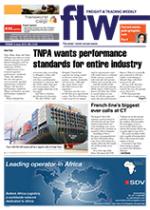A new study has revealed the
extent of the pronounced shift
from air to sea for perishable
cargo over the past decade,
with 100 000 TEUs per year
transported by ocean carriers.
Maritime adviser Derek
Brand, who authored
the report for shipping
consultancy Seabury, said
the shift was particularly
pronounced in certain
perishable commodities such
as tomatoes, capsicum, fresh
fish, lettuce and pineapples.
“New technology
in controlled
atmosphere
containers,
such as Star
Cool SA, has
the potential
to increase
the trend.
CA’s ability
to slow
down the
ripening
process
opens up ocean
transport as a
viable alternative
to air cargo on
some of the
longer trade routes,” said
Brand.
The Seabury report noted
that air freight had lost about
5.4 million tonnes of cargo
to ocean freight
since the year
2000 and had
lost over half
of its growth
potential due
to that shift.
However,
Safmarine’s
regional
head of
refrigerated
trade, John
Macdonald,
said there
would always be
demand for
airfreight in the perishables
industry. “The choice to use
air or ocean is driven by so
many variables in global
market conditions and it is
hard to predict year-on-year
which mode will be most
selected,” he said.
He said that the
introduction of live
temperature management
in reefer containers had
minimised risks of prolonged
transport and increased the
quality of the product upon
delivery.
“Ocean
transport for
perishables
– especially
citrus, apples, pears, avocados
and grapes, which Safmarine
transports – is extremely
reliable and of course much
more cost-effective,” said
Macdonald.
Furthermore, vessels can
usually make a plan to free up
reefer space to transport larger
volumes whereas airfreight
is limited in terms of the
volumes it can transport in the
belly hold.
Bernd Jülicher, managing
director at Skyservices – which
specialises in perishable
transport – told FTW that the
nature of the products they
transported mostly required
airfreighting, with volume and
timing dictating the need for
this. He conceded that ocean
was far more cost-effective
and offered better long-term
temperature control but
added that airfreight offered
a quicker transit time and
required lower minimum
volumes. To stay competitive
in an industry that has seen a
modal shift, Jülicher said that
the air cargo industry needed
to focus on its strengths
and optimise those to full
potential.
“Air cargoes will always have
an advantage with respect to
high value goods because of
the security associated with
air travel, so while numerous
fresh/frozen goods have made
the modal shift to sea freight,
the increase in volumes of
cell phones and computer
items has come to the aid
of the airfreight industry,”
said insurance specialist
Mike Brews of Horizon
Underwriting Managers.
He noted that the risks
between the two modes of
transport were very different.
“Airfreight items are seldom
refrigerated and more likely to
be chilled cargo and there is
therefore no risk of machinery
breaking down.” However,
these cargoes are also often
much more fragile and any
break in the cold chain is
likely to cause a high-valued
loss, added Brews. “The cost
of replacing goods damages is
also very high.”
INSERT & CAPTION
New technology
in controlled
atmosphere
containers has the
potential to increase
the trend.
– Derek Brand

